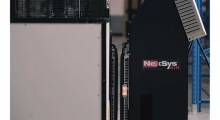John Krummel
Title: Committee chair for the Rack Safety Committee for the Rack Manufacturers Institute (RMI); president and CEO of Advance Storage Products
Location: Charlotte, N.C. (MHI); Huntington Beach, Calif.
Experience: More than 29 years in the pallet rack industry, including 25 years with RMI
Modern: John, this issue of Modern has a special focus on rack. Are you seeing any trends?
Krummell: As you know, because of e-commerce, there’s a lot going on in the distribution industry, and that’s driving demand for rack systems. Right now, lead times are out and everyone in the industry is busy. There are several trends. One is that rack systems are going higher as lift equipment improves. When I started in the industry, 30 feet was tall and now 45-feet heights are becoming common. Customers are also de-densifying their rack. It’s a combination of an increasing number of SKUs, but a lower inventory per SKU, end users want less density and more selectivity. And, we’re seeing a push for automation, driven by the need for efficiency and added density when compared with a conventional warehouse.
Modern: What’s happening in the Rack Safety Committee? I know you’ve launched several initiatives.
Krummell: For the past 10 or 15 years, our focus has been on the development of good design standards. Those standards have been incorporated into building codes across the country, and we’ve created the R-Mark Certification program. If you follow the design standards and buy good rack, you’re going to have a good safe warehouse. Now, we’re recognizing that there is a lifecycle to a rack system. I just visited a customer who is using the same rack system we sold them in 1992. What happens is that a customer installs the rack, and then leaves it. Over time, it may get damaged by lift trucks, or the warehouse manager may decide to reconfigure the rack because the needs have changed and does so without engineering support. Racks don’t fail very often, but when they do, and 3,000-pound pallets come crashing down, it’s serious.
Modern: How is the Rack Safety Committee addressing the lifecycle issue?
Krummell: We’re creating a proactive outreach program to the constituents that may have responsibility for safety of the rack system. For instance, the person who buys the rack may not be the operator, and the risk management manager may not know what constitutes a safe rack program. We want to reach those individuals who can help ensure that safe practices are followed.
Modern: What have you done so far?
Krummell: About three years ago, we published the “Guideline for the Assessment and Repair or Replacement of Damaged Rack” that outlines the best practices for repairing, reconfiguring or moving a rack system. For example, let’s say you have been storing 4-foot tall pallets and now you need to put away an 8-foot pallet. It’s easy to just take out the lower beam, right? But removing that support may create an unsafe rack system, like removing the bottom floor of your house. You have to go back to a qualified engineer who can do the calculations based on standards before you make those changes. In the last year, we’ve launched a program to raise awareness across the industry. We now have a Website—rmiracksafety.org. This year, we’re putting together a series of new educational videos, and we’re creating quick and easy reference materials geared toward operators. Finally, within RMI, we’re creating a sub-group for the rack safety companies that specialize in rack repair. Our goal is to bring them in as members so we can continue to promote providing repair solutions that meet RMI standards.
Modern: Any final thoughts?
Krummell: I’d just say that rack safety is evolutionary and not revolutionary. The standards are set and are incorporated into building codes across the country. Now, it’s time to work on the lifecycle. When a system is designed, installed and maintained to standard, a rack failure is a virtually unheard of event, so operators don’t think about it and pay little attention to the condition of the rack systems. But when a failure happens, it’s a serious thing. With an awareness campaign and the right collateral materials, the overall awareness is going to increase and our customers’ employees will be safer.
Article topics









